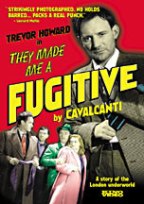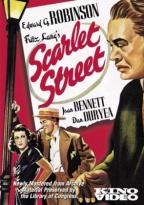
Another list of recommended books on Film Noir History & Theory from an Amazon.com customer with comments:
Film Noir: An Encyclopedic Reference to the American Style, Third Edition
by Alain Silver
Buy new: $25.55 / Used from: $14.35
The essential reference book for film noir of the classic period. Includes some discussion of neo-noir. Plot summaries, names, dates, and critical analysis for nearly 300 films.
Film Noir by Andrew Spicer
Buy new: $10.17 / Used from: $5.72
Concise and readable introduction to film noir theory. Covers classic, modern, and post-modern noir. Includes essays on 3 directors and lists of films.
The Dark Side of the Screen: Film Noir by Foster Hirsch
Buy new: $19.77 / Used from: $10.32
Another introductory text. Published in 1981, this was one of the first books on film noir written in English. Older and less comprehensive than the Spicer book, but still a solid introduction.
Dark City: The Lost World of Film Noir by Eddie Muller
Buy new: $16.47 / Used from: $11.94
Engaging survey of classic film noir written for a popular audience. Not intended to be comprehensive, but an winning introduction to great films for casual fans and noir buffs.
A Panorama of American Film Noir, 1941-1953 by Raymond Borde
Buy new: $11.53 / Used from: $6.95
Noir film theory’s seminal work, first published in France in 1955, on which all subsequent theory was built. Amazingly insightful, considering it lacked the benefit of hindsight.
Film Noir Reader by Alain Silver
Buy new: $22.95 / Used from: $5.60
Collection of essays written 1950s-1990s. Important seminal works, including Schrader’s “Notes on Film Noir”, plus modern studies of specific films and directors. Classic and neo-noir.
Film Noir Reader 2 by Alain Silver
Buy new: $15.60 / Used from: $6.85
More seminal essays, including Nino Frank’s, and an eclectic assortment of more recent essays that explore films, directors, themes, influences, and music. Classic and neo-noir.
Film Noir Reader 3: Interviews with Filmmakers of the Classic Noir Period by Alain Silver
Buy new: $22.50 / Used from: $14.06
Interviews with 18 directors, cinematographers, actresses, composers, writers, producers of the classic noir period, conducted by Robert Porfirio, Alain Silver, and James Ursini.
Film Noir Reader 4: The Crucial Films and Themes by Alain Silver
Buy new: $17.21 / Used from: $9.32
Mostly modern essays discussing key films and themes. Mixed bag. Some excellent historical studies, but too many essays rooted in socio-political agendas.
More than Night: Film Noir in Its Contexts by James Naremore
Buy new: $17.95 / Used from: $11.01
A scholarly analysis of “film noir” as an idea formed ex post facto that continues to resonate through contemporary media. Classic noir, neo-noir, and related crime films.
Detours and Lost Highways: A Map of Neo-Noir by Foster Hirsch
Buy new: $20.00 / Used from: $5.94
Follows neo-noir 1960-1999, as the style became a Hollywood mainstay. Analysis of old ideas and new trends, from the surprisingly retro to audaciously original films. Best book on neo-noir.
Shades of Noir: A Reader (Haymarket)
Buy new: $20.00 / Used from: $6.20
Ten highly academic essays focus on the origins of film noir motifs and their relationships to American culture. Classic & neo-noir. Dense, hard-core film theory. Not for casual fans.
New York Noir: Crime Photos from the Daily News Archive by William Hannigan
Buy new: $19.77 / Used from: $18.98
Not film theory, but it should be. These tabloid photographs from 1920s-1950s will disabuse you of the widely held belief that film noir’s vice, violence, and realism were products of the WWII era.
Somewhere in the Night by Nicholas Christopher
Buy used from: $2.31
Personal treatise focusing on elements of post-WWII urban environment which the author believes shaped film noir style. Interesting, thoughtful, but a stretch in terms of theory.
Out of the Past: Adventures in Film Noir by Barry Gifford
Buy new: $20.00 / Used from: $8.20
Barry Gifford’s personal take on 118 crime films released 1933-1988. If you find most film noir books too dry or academic, these energetic, entertaining essays might suit you.
L. A. Noir: Nine Dark Visions of the City of Angels by William Hare
Buy new: $39.95 / Used from: $25.00
Analysis of 7 classic noir films and 2 neo-noir films that take place in Los Angeles. Includes discussion of related films and the directors, actors, and writers involved in their creation.
L.A. Noir: The City as Character by Alain Silver
Buy new: $14.96 / Used from: $12.75
Classic and neo-noir in Los Angeles, with emphasis on how the city and its landmarks help create the noir mood. More than 150 b&w photos including many location photos indexed with addresses.
Film Noir by Alain Silver
Buy new: $13.59 / Used from: $6.20
Sleek, attractive showcase of over 180 photographs from classic noir films. Somewhat cursory analysis of 10 noir motifs and 10 representative films. Heavy on visuals, light on information.
Art of Noir: The Posters And Graphics From The Classic Era Of Film Noir
by Eddie Muller
Buy new: $34.65 / Used from: $25.00
A wonderful showcase of the brash, lurid poster art of classic film noir. 338 posters and lobby cards are reproduced in eye-popping color. Captions and essays expound on the bold styles.
Painting With Light by John Alton
Buy new: $19.77 / Used from: $11.99
Not film theory, but lighting theory. A handbook to cinematography written in 1949 by John Alton, low key lighting specialist and one of film noir’s most recognizable and revered cinematographers.
Its A Bitter Little World: The Smartest Toughest Nastiest Quotes From Film Noir
Buy new: $10.39 / Used from: $1.78
A nice little volume of hard-boiled quotes from film noir 1940-2005. Organized by date, theme, and indexed by film.
Hard Boiled: Great Lines from Classic Noir Films by Peggy Thompson
Buy used from: $1.88
Book of quotes from film noir and crime films 1932-1964. Organized by film, indexed by artist and first line. Includes reproductions of more than 60 movie stills and lobby cards.
















